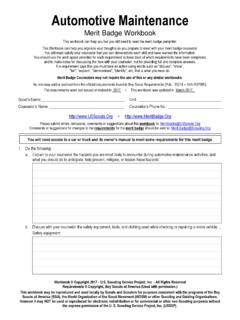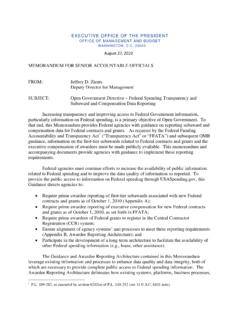Transcription of ARMY R 71-9, M REQUIREMENTS, 30 A 1997
1 95 August 1998 ARMY REGULATION 71-9, MATERIELREQUIREMENTS, 30 APRIL 1997 ProponentThe proponent for this document is the Army Deputy Chief of Staff for Site LocationThis document may be accessed from the Army Publications Office electronic publications searchpage at Developer (CBTDEV) - Command or agency that formulates and documents operationalconcepts, doctrine, organizations, and materiel requirements (MNS and ORDs) for assigned mis-sion areas and functions. Serves as the user representative during acquisitions for their approvedmateriel requirements as well as doctrine and organization Operational Capabilities (FOCs) - FOCs are statements of operational capabilities(needs) required for the Army to achieve the vision articulated in TRADOC Pam 525-5, ForceXXI Operations and for the Army Medical Department (AMEDD), TRADOC Pam 525-50, Opera-tional Concept for Combat Health Support. FOCs address specific warfighting operational ca-pabilities (not functions or operations) described in TRADOC approved concepts.
2 They describethose capabilities in operational terms, what must be done; not how to do it. The FOCs provide astand-alone description of the capability. FOCs are enduring; they apply to tomorrow's Army,but may be equally relevant to today's or yesterday's Army. FOCs do not describe a deficiency orshortcoming. They do not provide or identify a system specification, specific technology, organi-zation or time frame and they do not encompass an entire branch or functional concept. FOCs donot use relational or comparative words or Technology Integration (HTI) - The application of common technology solutionsacross multiple systems to improve the warfighting capability of the total force. It represents theholistic process of developing, integrating, and fielding of common or multi-use technologies,hardware and software into different types of weapon and information systems that fight togetheras units or task - The comprehensive technical effort to identify and integrate all relevant informa-tion and considerations regarding the full range of manpower, personnel, capabilities, capabili-ties, training development and delivery, human factors engineering, system safety, healthhazards, and soldier survivability into the system development and acquisition process to im-prove soldier performance, total systems performance, and reduce the cost of ownership to anacceptable level throughout the entire life cycle of a system.
3 MANPRINT is the Army s HumanSystems Integration process for systems Developer (MATDEV) - The Research, Development, and Acquisition command, agency,or office assigned responsibility for the system under development or being acquired. The termmay be used generically to refer to the RDA community in the materiel acquisition Developer (TNGDEV) - Command or agency that formulates, develops, and documentsor produces training concepts, strategies, requirements (materiel or other), and programs forassigned mission areas and functions. Serves as user (trainer and trainee) representative duringReport Documentation PageReport Date Aug 1998 Report Type N/ADates Covered ( to) - Title and Subtitle Army Regulation 71-9, Materiel requirements , 30 April1997 Contract Number Grant Number Program Element Number Author(s) Project Number Task Number Work Unit Number Performing Organization Name(s) and Address(es) Army AMEDD Center and School Fort SamHouston, TX 78234 Performing Organization Report Number Sponsoring/Monitoring Agency Name(s) and Address(es) Sponsor/Monitor s Acronym(s) Sponsor/Monitor s Report Number(s) Distribution/Availability Statement Approved for public release, distribution unlimitedSupplementary Notes Abstract Subject Terms Report Classification unclassifiedClassification of this page unclassifiedClassification of Abstract unclassified Limitation of Abstract UUNumber of Pages 696acquisitions of their approved training materiel requirements (MNS and ORDs)
4 And trainingprogram Development - The conception, development, and execution of solutions to trainingrequirements identified through the combat development process. The solutions may include newor revised training programs, material, methods, media, and system and non-system training requirements - requirements for Acquisition Categories (ACAT) I-IV weapons andmateriel systems, automated information systems, IT programs, special access program, andclothing and individual equipment in direct use by or support of the Army warfighter in trainingfor and conducting of operational missions (tactical or other), or connecting that warfighter tothe sustaining Rapid Acquisition Program (WRAP) - This program is directed at accelerating pro-curement of systems identified through TRADOC warfighting experiments as compelling suc-cesses that satisfy an urgent need. It is implemented within existing Army structure. WRAP iscompatible with and supports Federal Acquisition Regulation (FAR) and DoD and Army acqui-sition policy.
5 (DoD 5000 series and AR 70 series). WRAP applies to Advanced Warfighting Ex-periments (AWEs), Concept Evaluation Programs (CEPs), Advanced Technology Demonstrations(ATDs), Advanced Concept Technology Demonstrations (ACTDs), and similar experiments whereTRADOC ICT supported by a TRADOC Battle lab are directly involved. Approved programs maybe funded as prototype for 2 years. Immediate funding is not guaranteed. Continued actions willbe needed to fully document system, obtain standard type classification, and full logistics regulation is a revision of the 1987 AR 71-9. It covers policies and procedures for warfightingmateriel requirements . This revision: describes the Army s new way of determining warfighting materiel requirements ; implements DoD Directive and DoD Regulation ; assigns responsibilities for the combat development portion of the materiel acquisitionmanagement process; mandates the use of the formats prescribed by the Chairman of the Joint Chiefs of StaffInstruction (memorandum of policy 77) in the preparation of materiel requirementsdocuments; provides the policy for streamlining requirements through horizontal technology integra-tion and the Warfighting Rapid Acquisition Program.
6 And updates policies for preparing requirements documents and conducting supporting following policy guidance describes the necessary procedures for materiel requirements :Department of Defense (DoD) Directive (DoDD) and DoD Regulation provide man-datory DoD acquisition policy and procedures including requirements documentation and approvalguidance for major defense acquisition programs (MDAP) for both materiel and automated informa-tion systems. Chairman of the Joint Chiefs of Staff Instruction (CJCSI) (Memorandum ofPolicy (MOP) 77 - requirements Generation System) mandates policy and procedural guidance forthe requirements generation system to include guidance on key performance parameters (KPPs),measures of effectiveness, and the Joint requirements Oversight Council (JROC). AR 70-1 pro-vides Army acquisition guidance for materiel and information systems. This regulation providesArmy requirements determination and documentation policies and responsibilities supporting allArmy acquisitions categories (ACAT) I/IA through IV materiel and information systems.
7 The97terms materiel and materiel system in this regulation will apply to materiel and information systemsunless specifically identified otherwise. Governing policies follow: The requirements determination process will provide a current and future Army capable ofsuccess in any contingency from humanitarian assistance to full tactical operations injoint and combined environments. The process will be responsive to the urgent materielrequirements of the deployed warfighter as well as project the full set of doctrine, training,leader development, organizational design, materiel, and soldiers (DTLOMS) requirementsfor the Army to be mission capable in near-, mid- and far-term operations. Field Commanders document and submit their urgent warfighting and training op-erational requirements and obtain support via the operational needs statements(ONS) process in chapter 3. Commanders with combat development missions conduct continuing analyses toidentify and define near through far term DTLOMS requirements .
8 Near term requirements occur when a field commander s ONS represents a broadArmy mission urgent requirement with solution, a solution is found for a previouslyidentified continuing urgent operational capability, or technology provides previ-ously unforeseen critical leap-ahead operational capability. Near-, mid-, and far-term (that is, future) operational requirements will be operationsconcepts based, holistic operations oriented, and capabilities focused. Future operational requirements for all DTLOMS domains will be related to the ArmyTraining and Doctrine Command (TRADOC) approved overarching operational conceptand associated lower level operational concepts. requirements not related to these con-cepts will not be resourced. TRADOC integrated and approved listing of future opera-tional capabilities (FOCs) [see TRADOC PAM 525-66, Future Operational Capability] fromthese concepts serve as a control mechanism for requirements determination process, andauthority for supporting studies and experimentation, and a device for linkage betweenrequirements documentation and the concepts.
9 requirements determination is the work of integrated concept teams (ICTs) made up ofpeople from multiple disciplines. These teams' efforts may include concept developmentor development materiel operational requirements development and solution sets will be documented in ICT minutes or reports. ICTs will operate onprincipals similar to acquisition integrated product teams (IPTs) in DoD to identifyand resolve issues early. An ICT will include representatives of Army requirements proc-ess stakeholders and other principal contributors, including academia and industry, whenappropriate. The Office of the Secretary of Defense (OSD), other services, commanders inchief (CINCs), and Joint Staff, will be invited to send representatives, as appropriate,when their interest is known or suspected. A materiel requirement will only be developed for an approved FOC after all other possibledoctrine, training, leader development, or organizational solutions are deemed unable tosolve the FOC.
10 The priority order of consideration is doctrine, training, leader develop-ment, organizational design, and finally materiel. Mission need statements (MNSs) will beprepared in accordance with MOP 77 format guidelines for those materiel operational re-quirements with ACAT I or IA program potential and other programs representing a newArmy mission or a potential program using a significant leap-ahead technology. Opera-tional requirements documents (ORDs) will be prepared in accordance with DoD guidance for all warfighting materiel operational requirements . All ACAT I, IA, II, III, and IIIA materiel programs will have an ORD. All ACAT IV materielprograms for modification table of organization and equipment (MTOE), deployable tablesof distribution and allowances (TDA), warfighter training, operations planning and re-98hearsal, and information technology (IT) providing interface to deployed units, will haveORDs. Most ACAT IV base operations materiel are not warfighting requirements , will nothave ORDs, and can be procured following major Army command (MACOM) standardacquisition procedures.
















